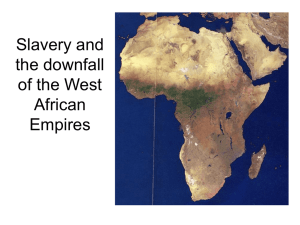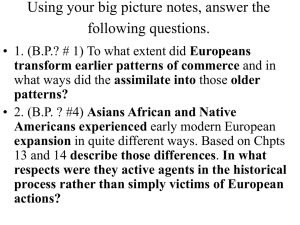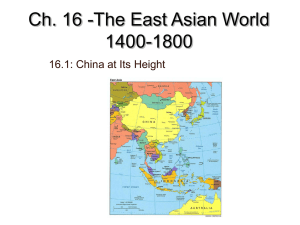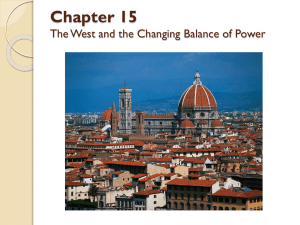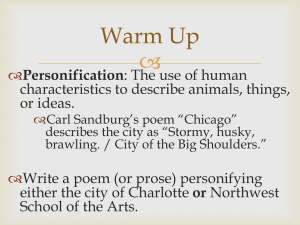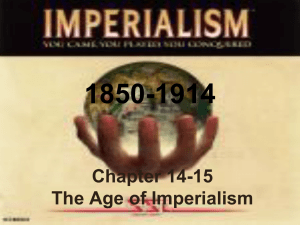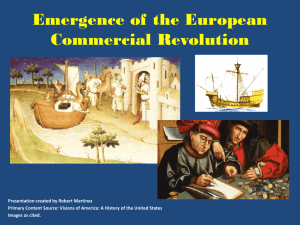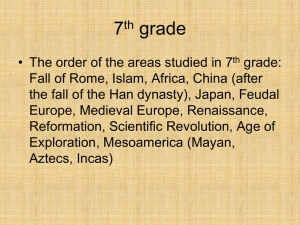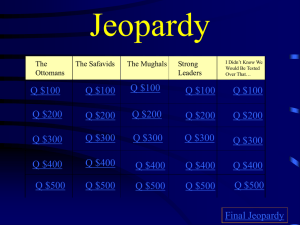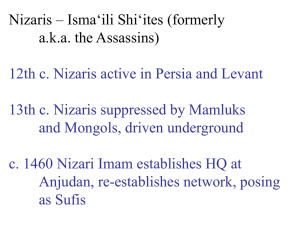Chapters 20,21,22: Africa and the Slave Trade, the Gunpowder
advertisement
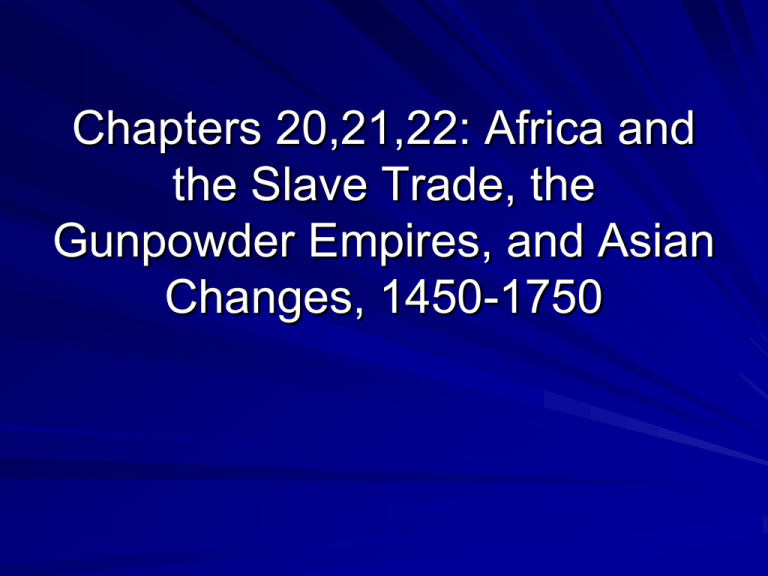
Chapters 20,21,22: Africa and the Slave Trade, the Gunpowder Empires, and Asian Changes, 1450-1750 Africa: 1450-1750 No longer aligned with the Islamic world trading system Forceably brought into the Atlantic trading system Heterogeneous societies and cultures The Empire of Mali Located in the Sahel region south of the Sahara, became powerful after 750 CE Wealthy center of trade Part of Dar al’Islam Rich in gold, agriculturally fertile Capital: Timbuktu Timbuktu: A Major Cultural Center Timbuktu: A Major Cultural Center The Mosque of Jenne Mansa Musa 1312-1337: Greatest King of Mali Songhay After the decline of Mali the Kingdom of Songhay gained power in the Sahel Powerful cavalry and navy Muslim dominated Standardized weights, measures, and currency Greatest King: Sonni Ali 1464-1492 The Swahili Coast Eastern coast of Africa Long term involvement in Indian Ocean trade Portuguese and other European influence Cosmopolitan city-states Predominantly Muslim Swahili language: a lingua franca Traded with the interior of Africa English and Swahili Car Bicycle Motorbike Train Boat Aeroplane Petrol Mechanic Gari Baiskeli Pikipiki Gari la moshi Mashua Ndege [Eropleni] Petroli Fundi Coffee Tea with/without milk/sugar Danger! Fetch a doctor Chemist Kahawa Chai na/bila maziwa/sukari Hatari! Ita daktari Duka la dawa Great Zimbabwe Southern African kingdom Traded with the Swahili Coast and the African interior Too far inland to be affected by Islam The only fully African civilization, with no outside cultural influences Ruins of Great Zimbabwe The Forest Kingdoms of West Africa First area to be exploited by Europeans Dominant region: Benin Benin art: highly detailed and realistic Source of most slaves taken to the Americas Benin Art The Atlantic Slave Trade: Beginnings Contact between Europeans and Africans began in late 1400s with Portuguese expeditions along the coast At first Europeans saw Africans as being equal to themselves Europeans and Africans studied at universities, exchanged ambassadors, and communicated between rulers Christian missionaries traveled to Africa Africans and Slavery Slavery was an indigenous part of African culture Slavery among Africans was usually temporary The Atlantic Slave Trade Begins European “discovery” of the Americas led to exploitation of Africans Native Americans quickly died off from overwork and disease Europeans needed a new source of coerced labor By 1600, slaves were the largest trade item from Africa The Atlantic Slave Trade 1450-1850: about 12 million Africans were shipped to the Americas As many as 4 million more Africans were killed in internal slaving wars African rulers participated in the slave trade by gathering slaves and bringing them to coastal forts Portuguese, Dutch, French, and British all established posts and fortresses along the west coast of Africa for buying slaves African Captives in Yokes The Middle Passage The Triangle Trade A typical slave ship’s layout “Coffin” Position: Onboard a Slave Ship Slave Ship Interior African Slavery in the Americas Primary destination of most slaves: Brazil and the Caribbean Islands Typical life expectancy of a healthy male slave on arrival: 6 months No natural increase among the slave population in most areas North American Slavery Labor on tobacco and rice plantations was less “onerous” There was a natural increase among North American slaves Consequences of Atlantic Slave Trade Long term population decline in West Africa Transfer of African foods and customs to the Americas American food crops introduced in Africa Africans in the Americas were converted to Christianity, but sometimes maintained elements of African religions Europeans in South Africa The Cape of Good Hope was reached by the Portuguese in the late 1400s The Dutch established a colony there in 1652. Their settlers were called Boers Expansion brought the Boers into contact and conflict with the indigenous Bantu, Zulu, and other African peoples In 1815 the British took control of South Africa Conflict continued between the Boers, British, and the indigenous Africans The Gunpowder Empires Ottomans (Middle East, primarily Turkey, and Eastern Europe) Safavids (Iran) Mughals (India) The Gunpowder Empires Military power based on gunpowder weapons Islamic (Ottomans and Mughals: Sunni; Safavids: Shi’a) Political absolutism Cultural renaissances Less powerful than Western Europe The Ottoman Turks One of several Turkic tribes which entered the Middle East and converted to Islam Powerful military led by Janissaries In 1326, captured the town of Bursa near Constantinople Built navies and seized control of the eastern Mediterranean Conquered much of Balkan Peninsula Janissaries Constantinople captured, 1453 Captured by Sultan Mehmed II End of the Byzantine Empire Constantinople (Istanbul) was rebuilt and gained population and wealth Tolerance for dhimmis More emphasis on military than economic power “conquest over commerce” Ottoman Empire continued to expand for the next century Ottoman Sultans were also the Caliphs of (Sunni) Islam Suleiman the Magnificent 15201566 Greatest Ottoman ruler Called “The Lawgiver” or ‘The Just” by Muslims Codified the Shari’a Rebuilt and beautified Istanbul Patron of the arts, poet, made Istanbul a center of Ottoman cultural flowering Suleiman’s Poetry Some of Suleiman's verses, have become Turkish proverbs, including the well-known "Everyone aims at the same meaning, but many are the versions of the story," and "In this world a spell of good health is the best state” He wrote in Turkish, Persian, and Arabic. – "The people think of wealth and power as the greatest fate, – But in this world a spell of health is the best state. – What men call sovereignty is a worldly strife and constant war; – Worship of God is the highest throne, the happiest of all estate's” Tughra or Monogram of Suleiman The Topkapi Palace The Blue Mosque of Constantinople Suleimanye Mosque Miniature Painting: An Ottoman Art Form The Piri Re’is Map, a mystery from Suleiman’s time It appears to show the west coast of Africa, the east coast of South America, and the northern (land) coast of Antarctica A map belonging to the Turkish Admiral Piri Re’is ca 1514 Appears to be based on older maps Shows accurate use of longitude Suleiman and the Europeans Suleiman recognized that Europe was a major potential threat to the Ottoman Empire and to Islam He attempted to destabilize Europe with several invasions He also provided financial support to Protestants The death of Suleiman and the decline of the Ottomans As Suleiman grew older he lost interest in government and allowed the bureaucracy to rule alone He allowed his sons to be raised uneducated in the harem, dominated by their mothers This set a precedent for future Sultans and their sons Selim II, The Drunkard 1566-1574 The first “disinterested” Ottoman sultan Defeated by the Spanish at the Battle of Lepanto in 1571, lost control of the Mediterranean Ottoman Decline Over the next several centuries, the Ottoman Empire gradually declined Europeans gained control of the seas and ended Muslim trade monopolies Succession problems and uneducated Sultans European economic competition Technological and cultural conservatism Janissaries held power and blocked reforms The Safavids Turkic tribe which entered Iran Converted to Shiite Islam Isma’il 1494-1524 Took control of the Safavids in 1494 at the age of 7, claimed to be the Hidden Imam By 1512 he controlled all of Iran and became the first Safavid Shah Defeated by the Ottomans at the Battle of Chaldiran in 1514 (blocked Shiite expansion) Shah Abbas I 1588-1629 The greatest Safavid ruler Made alliances with Europeans against the Ottomans Encouraged trade and commerce with Western Europeans Period of great wealth and cultural creativity Mixture of Persian and Islamic influences Isfahan: The Safavid Capital Safavid Architecture Safavid Poetry (Rumi) O you who've gone on pilgrimage where are you, where, oh where? Here, here is the Beloved! Oh come now, come, oh come! Your friend, he is your neighbor, he is next to your wall You, erring in the desert what air of love is this? If you'd see the Beloved's form without any form You are the house, the master, You are the Kaaba, you! . . . Where is a bunch of roses, if you would be this garden? Where, one soul's pearly essence when you're the Sea of God? That's true - and yet your troubles may turn to treasures rich How sad that you yourself veil the treasure that is yours! Ottomans and Safavids Compared The Ottomans were more market-oriented than the Safavids Safavid women had more freedom and were less secluded than Ottoman women The Ottomans had a larger territory and more resources. Decline and Fall of the Safavids Succession problems after the death of Abbas I European economic competition Religious conflict between Sunnis and Shiites 1722: Safavids collapsed The Mughals Descended from the Mongols Influenced by Chinese and Islamic cultures Originated in Turkestan in Central Asia Sunni Muslims with Sufi influence Babur “the Tiger” 1483-1530 Invaded present day Afghanistan and then northern India Defeated the Delhi Sultanate First Muslim to use gunpowder weapons (muskets and artillery At the same time, Europeans were beginning to have contact with India from the sea Humayun 1530-1556 From 1530-1540, lost all of his father’s empire in a series of rebellions Went into exile in Persia and rebuilt his army (Persian culture introduced to Mughals) By 1555, managed to reconquer the Mughal Empire Humayun’s Tomb in Delhi Akbar the Great 1556-1605 Greatest ruler of Indian history Became Shah at age 13 Completed the conquest of Northern India Developed an efficient bureaucracy Attempted to win over Hindus The Din-i-Ilahi: “The Religion of God” Attempted to synthesize the world’s religions into one Predominantly based on Islam Elements of Hinduism, Jainism, and Zoroastrianism Asked Christian missionaries to participate Eventually rejected by both Muslims and Hindus Jahangir 1605-1628 Conquered Eastern India Patron of the arts “The Age of Mughal Splendor” Mughal Art The Red Fort, Delhi Mughal Architecture Jahan 1628-1658 Expanded Empire Defeated the Portuguese Known for magnificent architectural projects Mumtaz Mahal Jahan’s favorite wife Died in 1631 giving birth to her fourteenth child Jahan built the most magnificent tomb possible: The Taj Mahal Combination of Indian, Persian, Chinese architectural styles Aurangzeb 1658-1707 Shah Jahan’s building projects and taxes caused rebellions among the Hindus Aurangzeb overthrew and imprisoned his father in 1658 and became Shah Expanded the Mughal Empire to its greatest extent Aurangzeb 1658-1707 Devout Muslim who insisted Shar’ia become the law of the land Persecuted Hindus, closed temples, outlawed practice of sati Renewed taxes on non-Muslims which had been ended by Akbar the Great Revolts began, aided by Europeans in India By early 1700s Mughals were losing control of India and Europeans were gaining influence Sikhs A major Indian religion which began in the 16th century under the Mughals Centered in Northern India, 23 million followers Began with Guru Nanak (15691539) Total of 10 Gurus (the last died in 1708) Mystical, egalitarian, disciplined Major political and economic force in India and Pakistan Comparisons of the Declines of the Gunpowder Empires Internal weaknesses and conflicts Overexpansion Weak, incompetent rulers Muslim contempt for Europeans meant the Europeans were underestimated Economic and military decline as Europeans gained power The World in 1700 Asia and European Contact 14501750 Europeans were not powerful enough to exploit Asia during 1450-1750 Europeans at first had difficulty trading for Asian goods since they had little or nothing the Asians valued Europeans were only able to trade successfully with Asia after they gained access to the New World’s precious metals The Asian World in 1700 Chapter 22 p. 482 European Trade With Asia Using superior naval technology, the Portuguese were able to establish a trade network in the Indian Ocean by 1507 By the later 1500s, the Dutch, French, and the English had driven out the Portuguese The Dutch took control of the Spice Islands (modern Indonesia) The French and English concentrated on India European Missionaries Roman Catholic Christianity was introduced into the Philippines by the Spanish, where it merged with local animistic beliefs and traditions Elsewhere in Asia, Christianity became a minority religion Ming China 1368-1644 Oldest, largest, and richest civilization Part of the world economy, but foreign trade was only a small part of the Chinese economy Silk, porcelain, and cotton were major exports, with tea becoming increasingly important Ming China’s Economic Impact on the World Ming China used silver as its monetary metal The Single Whip tax on all Chinese had to be paid in silver Therefore, Ming China was a major importer of silver in exchange for trade goods The largest source of silver was the Americas Ming China’s Agricultural Revolution New World crops such as corn, peppers, and the sweet potato were introduced to China Crop rotation Massive reforestation China’s population grew from 65 million in 1400 to 300 million by 1800 Ming China’s Commercial Revolution Population growth led to increased urbanization Small businesses specialized in porcelain, tea, silk, cotton, and paper manufacturing European trade with Ming China was tightly controlled by the Chinese government, which was wary of foreign influence Decline and Fall of the Ming Little Ice Age related climate problems were especially severe in the early 1600s Incompetent emperors were unable to help Famine and natural disasters led to peasant rebellions In 1644 the Manchus invaded, destroyed the Ming, and established the Qing Dynasty Japan Japan 1450-1750 Ca 1467-1600 Warring States period: no central leadership (Emperor only ceremonial) 1543: Portuguese traders arrived in southern Japan. Other Europeans followed Portuguese and other Europeans served as middlemen, carrying goods between Japan and China Territorial dispute today Senkaku Islands Christianity in Japan Catholic missionaries led by Francis Xavier arrived beginning in 1549 Christianity had great appeal in Japan, and many converted, especially on island of Kyushu Japanese converts traveled to Europe to meet the Pope Japan’s reaction to European contact Fascination with the “nanbanjin” Intense interest in learning about and from the Europeans Large amount of trade between Japanese and Europeans Jesuits in Japan p.501 Tokugawa Ieyasu By 1598, had managed to unify Japan under his rule Tokugawa Shogunate 1598-1868 Distrusted Europeans and Christians as potentially disloyal to his rule Restrictions placed on European traders and missionaries Japanese Christians were persecuted Sakoju Jidai: National Seclusion By mid 1600s all European traders were banned except the Dutch Dutch traders were only allowed in Nagasaki Japanese were not allowed to travel abroad, and foreigners were forbidden to enter Christianity was suppressed The Tokugawa Shogunate 1. 2. 3. 4. Centralized government under Confucian principles Four social classes Samurai Farmers Artisans Merchants The Tokugawa Shogunate Urbanization, with three major cities: Edo, Kyoto, Osaka Rice was the staple crop Urban areas had many small businesses and industries Confucianist schools allowed most men and some women to become literate Dutch studies group studied European books in Nagasaki
